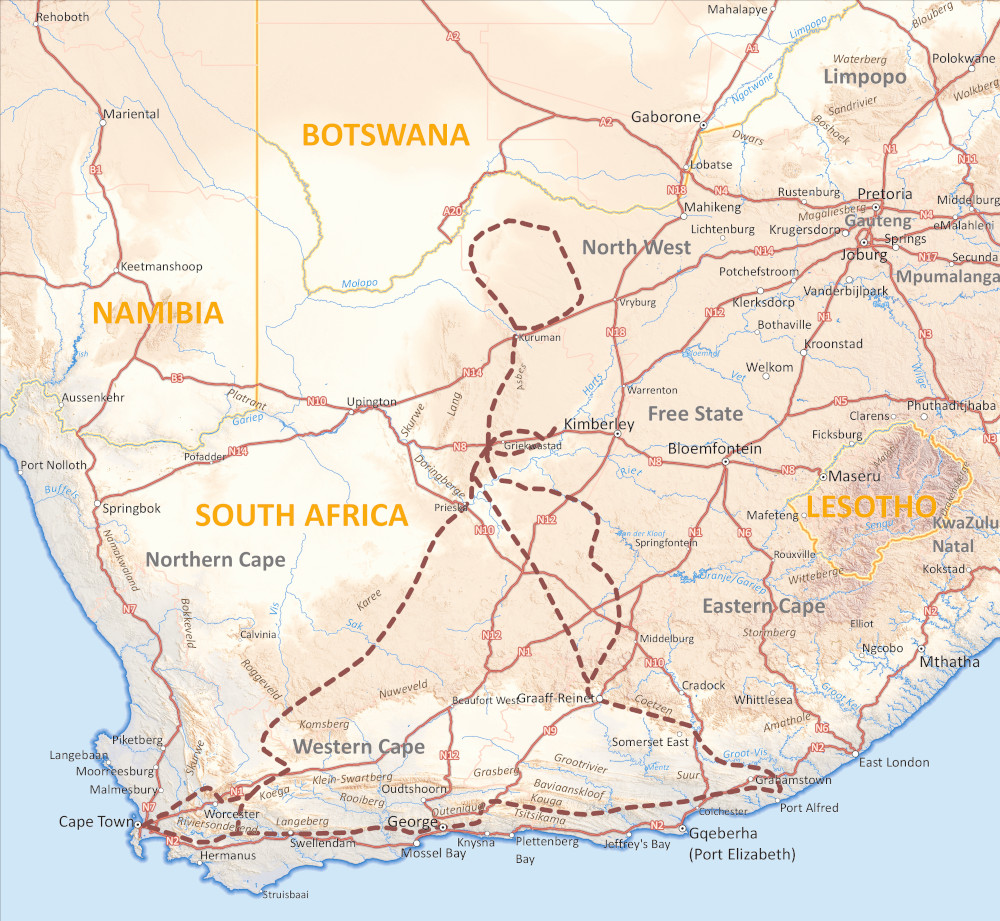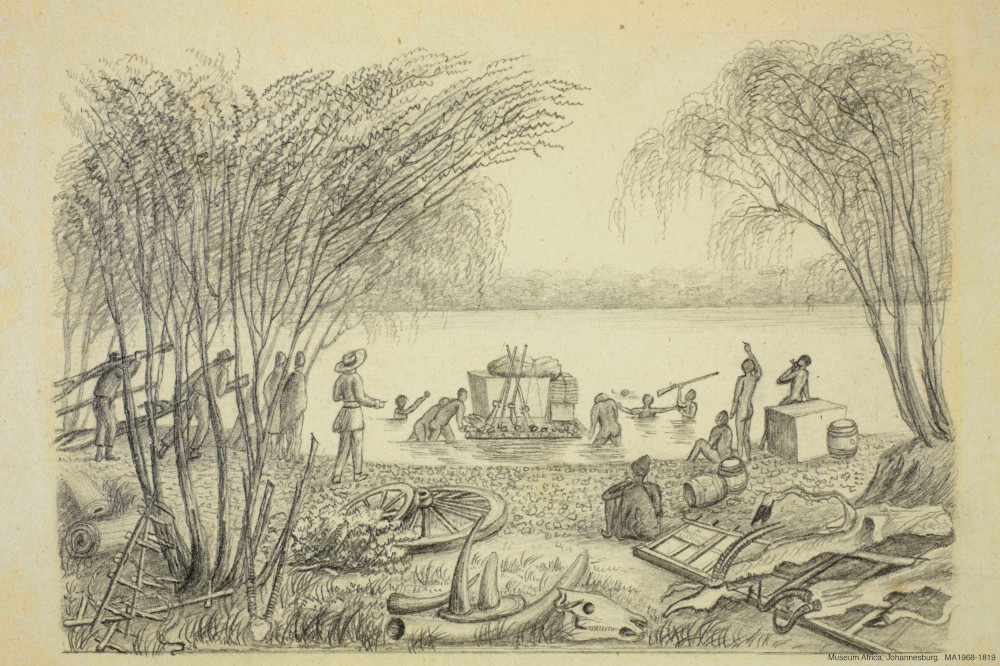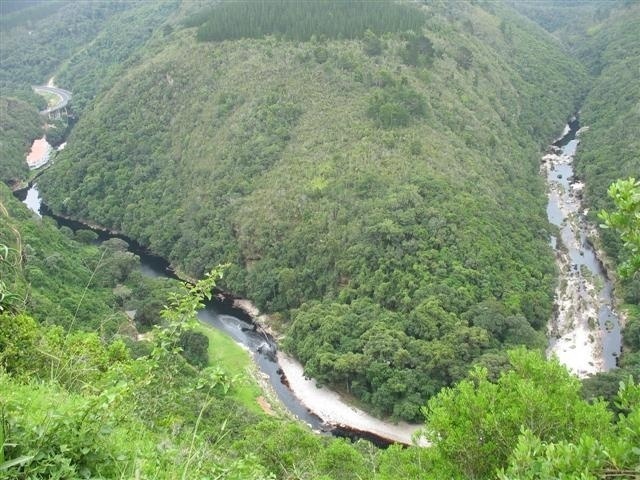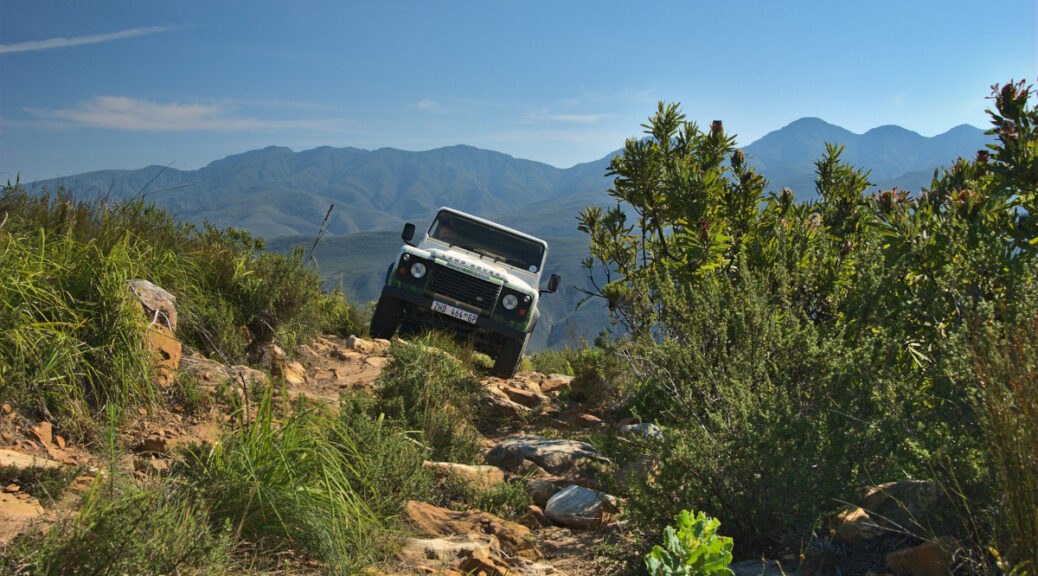New information on the return journey of the intrepid explorer and naturalist William Burchell opens up more opportunities and inspiration for modern adventurers. By Roger Stewart and Marion Whitehead
“Whoa!” Standing hard on the brakes of the Land Rover Defender seemed to make little difference on a steep descent on the Burchell 4×4 Trail at Pietersrivier Private Nature Reserve in the Garden Route’s Keurbooms River valley.
“Now you know a little of what the early travellers experienced in their ox wagons,” chuckled Katot Meyer. After a veld fire revealed an old sled track on his farm, the field historian and 4×4 enthusiast did a little sleuthing into old routes between the Langkloof valley and Plettenberg Bay. He discovered this was the track (see picture above) that the great British naturalist and explorer, William Burchell, used in 1814. Katot now welcomes 4x4ers to drive in Burchell’s actual tracks in a landscape that has changed little in the last 200 years. The trail is a chance to experience some of the challenges the early pioneers faced.
William Burchell, pioneer overlander
During his four-year ox wagon trek around southern Africa from 1811 to 1815, Burchell collected an astounding 63 000 specimens. He described many of these plants, birds, reptiles, insects and mammals for the first time for science. It seems that everything about the African veld fascinated him and he documented it all, from the rocks underfoot to the stars at night. He made friends with everyone, from high-ranking officials to poor San hunter-gatherers. He even took the trouble to learn Afrikaans before setting out on his long journey.
His book, Travels in the Interior of Southern Africa, provides fascinating insights into this world. However, it covers only the outbound journey, from Cape Town to the mission station of Klaarwater (Griekwastad), and Litakun, capital of the Bachapin people on the edge of the Kalahari. Until recently, little was known about the rest of his journey when he continued into the Kalahari in the vicinity of Kuruman. After returning to Klaarwater, Burchell trekked across what was then uncharted territory in the Great Karoo to Graaff-Reinet. He then journeyed along the Cape Colony’s turbulent eastern frontier to the mouth of the Great Fish River. From there, he took established wagon tracks to Uitenhage, continuing down the Langkloof pretty much on what is now Route 62. He crossed the mountains to Plettenberg Bay on Katot’s Burchell’s 4×4 Route, before trekking along the coastal plateau back to Cape Town.

Burchell’s eventful return journey
Our new book, Burchell’s African Odyssey: Revealing the return journey 1812-1815, spills the beans on what happened on the rest of his long trek. Some highlights include:
- Identifying the first white rhino near Kuruman (known for many years as Burchell’s rhino)
- Dismantling his wagons to cross the flooded Gariep River on rafts in the vicinity of Prieska
- Fireside music evenings with the local inhabitants deep in the Great Karoo
- Roaming the Boschberg forests at what is now Somerset East after years in arid landscapes
- Adding a cheetah to his collection near Riebeek East
- Negotiating the steep river crossings along today’s Garden Route – after the dreaded Touw River Pass, he trekked past today’s Map of Africa viewsite before tackling the feared Kaaiman’s River Pass outside George


He took every opportunity to hike deep into the Outeniqua and Langeberg mountains. Some of the plants he collected are now rare and seldom seen, such as Erica ixanthera. Members of Custodians of Rare and Endangered Wildflowers (CREW) report finding this erica only in a single kloof near today’s Garcia Pass outside Riversdale where Burchell first documented it.
There were also some disasters, like a broken disselboom in a remote part of the Great Karoo. A wagon got stuck in the sand at the mouth of the Kowie River on a rising tide and raiding Xhosa warriors made off with two spans of oxen in the Eastern Cape. The resourceful Burchell had to come up with a plan each time to continue his trek in the service of science.
Picking up the trail 200 years later
It’s taken years of research to fill in the events and experiences of Burchell’s missing years. His own map, as well as his drawings, field notes and letters preserved in archives and museums were a great starting point. Any traveller who’s been on a long journey and faced even mild challenges will marvel at the guts of this Englishman. He had never camped outdoors until he came to Southern Africa, but he set out in an ox wagon into wild and often unexplored territory. Along the way he learned many life lessons while adding to our knowledge of the natural sciences.
It’s no wonder outdoor enthusiasts are keen to follow in his wagon wheel tracks, even some 200 years later. Apart from Burchell’s 4×4 Route in the Pietersrivier Nature Reserve, the section of his outbound route from Karoopoort to Sutherland via Verlatenkloof beckons. This challenging route may need a 4×4 in winter.

Others have tried to replicate the route Burchell took on the Chue Loop from Litakun to what is today Heuningvlei in the Northern Cape – we know of someone who did this in his bakkie. Then there was a keen journalist who, in 2012, tracked Burchell’s route from Prieska to Graaff-Reinet on his mountain bike and ended up with a severe case of dehydration. The challenge remains for the adventurous souls out there!
For more information on Burchell’s routes (including video presentations), see www.burchellsodyssey.com
 Roger Stewart and Marion Whitehead are authors of the new book, Burchell’s African Odyssey: Revealing the Return Journey 1812-1815 (Struik Nature, 2022).
Roger Stewart and Marion Whitehead are authors of the new book, Burchell’s African Odyssey: Revealing the Return Journey 1812-1815 (Struik Nature, 2022).
Win the book
One lucky Tracks4Africa user will win a copy of Burchell’s African Odyssey. For a chance to win, send the answer to the below question, along with your name, daytime delivery address and contact number to competition@tracks4africa.co.za. Competition closed 20 October 2022. The winner will be notified by email and their name published on the website.
Question: What was the name of the naturalist who explored South Africa between 1812 and 1815 and collected more than 60,000 specimens?
Winner: Ernest Blom

